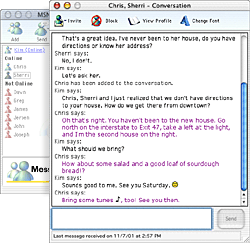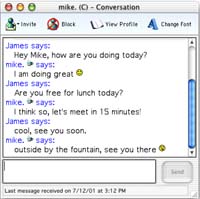Preston Smalley
MSN Messenger for Mac:
I managed and drove specification development for the second
release of MSN Messenger Service for the Macintosh while I was at Microsoft.
I eliminated a number of the usability issues present in the 1.0 product, added
user requested features, and brought the back-end of the software up-to-speed
with its Windows sibling.
Defining Users and Product Goals:
 I researched the competitive landscape, spoke with our support staff, worked
with marketing, and understood the engineering challenges by talking with our
developers and testers. I worked hard to understand our Macintosh user base
and created a number of typical user scenarios based on personas defined by
the MSN user experience team.
I researched the competitive landscape, spoke with our support staff, worked
with marketing, and understood the engineering challenges by talking with our
developers and testers. I worked hard to understand our Macintosh user base
and created a number of typical user scenarios based on personas defined by
the MSN user experience team.
Teamwork:
Surrounded by "Windows people" in Redmond, I made
sure to speak with Mac users on a regular basis. I elicited feedback from a
number of Mac product designers and got feedback on my design. Not only did
the end product improve through these interactions but laid the foundation
for future collaboration between the my team and the Mac team at Microsoft.
Design:
I improved the product by designing and redesigning several features. For example
under the existing design, a toolbar button on the conversation window remained
gray unless a person who was not on your buddy list began chatting with you
at which point it turned into the "Add" button. It was not only unclear
what the button did but also took up valuable screen real estate and added
to the cognitive load of the window.

The new design I proposed utilized a "pattern" I
saw in Entourage for the Macintosh. Instead of a button, a yellow information
bar would appear when this situation occurred informing the user that the person
they are chatting with is not added to their own contact list. Clicking the
hyperlink adds the user and the yellow bar disappears. This design answers
the user goal of being able to chat again with the person and does so in an
informative and non-intrusive way.
 Results:
Results:
I facilitated two reviews of this spec which refined it and built support among
the team. The end product was a software specification that was implemented
by an outside development company. The 2.0 version of Messenger reduced support
costs, drove user downloads (with new features), met federal COPPA requirements,
provided a robust platform for .Net Alerts on the Macintosh, and supported
the latest Messenger protocols.
Abilities Used:
Interaction Design (Scenarios, Storyboards), Program Management, Macintosh
HCI guidelines, Software Design, Adobe Photoshop, Visio, Microsoft Frontpage,
and Bug Management.
Update:
Following my work, the Mac Business Unit has assumed management of the Macintosh
client for Messenger and have integrated it with both of their latest versions
of Office. Version 2.0 of Messenger was Released to the Web (RTW) on July 19,
2001. See MSN
Messenger for Mac for more information.
<-- Back to Case Studies
 I researched the competitive landscape, spoke with our support staff, worked
with marketing, and understood the engineering challenges by talking with our
developers and testers. I worked hard to understand our Macintosh user base
and created a number of typical user scenarios based on personas defined by
the MSN user experience team.
I researched the competitive landscape, spoke with our support staff, worked
with marketing, and understood the engineering challenges by talking with our
developers and testers. I worked hard to understand our Macintosh user base
and created a number of typical user scenarios based on personas defined by
the MSN user experience team. 
 Results:
Results: